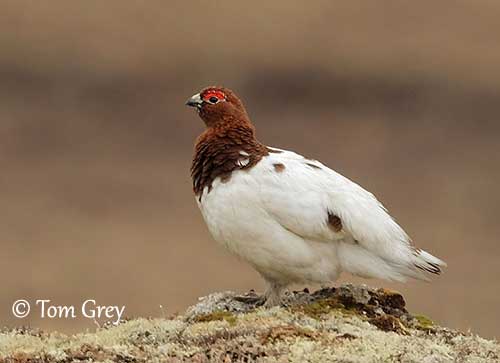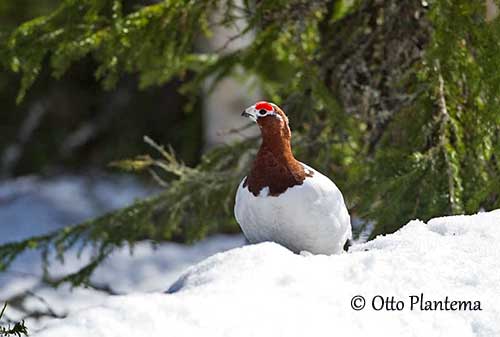
Fr: Lagopède des saules
Ang: Willow Ptarmigan – Willow Grouse
All: Moorschneehuhn
Esp: Lagópodo
Ita: Pernice bianca nordica
Nd: Moerassneeuwhoen
Sd: Dalripa
Photographers:
Tom Grey
Tom Grey's Bird Pictures & Tom Grey's Bird Pictures 2
Tom Merigan
Tom Merigan’s Photo Galleries
Otto Plantema
Trips around the world
William Price
PBase-tereksandpiper & Flickr William Price
Simon Tan
PBase Bird galleries
Text by Nicole Bouglouan
Sources:
HANDBOOK OF THE BIRDS OF THE WORLD Vol 2 by Josep del Hoyo-Andrew Elliot-Jordi Sargatal - Lynx Edicions - ISBN: 8487334156
THE HANDBOOK OF BIRD IDENTIFICATION FOR EUROPE AND THE WESTERN PALEARCTIC by Mark Beaman, Steve Madge - C. Helm - ISBN: 0713639601
L’ENCYCLOPEDIE MONDIALE DES OISEAUX - Dr Christopher M. Perrins - BORDAS - ISBN: 2040185607
FIELD GUIDE TO THE BIRDS OF NORTH AMERICA - National Geographic Society - ISBN: 0792274512
Animal Diversity Web (University of Michigan Museum of Zoology)
All About Birds (Cornell Lab of Ornithology)
Wikipedia, the free encyclopaedia
What Bird-The ultimate Bird Guide (Mitchell Waite)
BIRD SPECIES AND DISTRIBUTIONS IN YUKON-CHARLEY RIVERS NATIONAL PRESERVE
50 States.com - Alaska State Bird - Willow Ptarmigan - Lagopus lagopus
Alaska Department of Fish and Game
Willow Ptarmigan or Willow Grouse
Lagopus lagopus
Galliformes Order – Tetraonidae Family
INTRODUCTION:
The Willow Ptarmigan is also known as the Willow Grouse in Ireland and Britain. Typical bird of the Arctic tundra, it is the largest of the ptarmigan species. All are included in the family Tetraonidae.
The plumage of the Willow Ptarmigan varies according to the season. It is all white in winter for effective camouflage from predators. It becomes light brown to rufous in summer, following some intermediate phases.
It is found in broad range throughout Canada, Scandinavia, Finland and Russia. It is associated year round with dwarf willows on the tundra. It often feeds on willow buds and twigs, giving the bird its name.
The Willow Ptarmigan is the official Alaska’s state bird since 1955. It is widespread and common throughout the range and currently, this species is not globally threatened.

DESCRIPTION OF THE BIRD:
Biometrics:
Length: 36-43 cm
Weight: M: 535-900 g – F: 410-750 g
The Willow Ptarmigan in winter plumage is all white, except for the black tail. Legs and feet are feathered white. The bill is black. The eyes are very dark. The female is similar.
During spring and autumn, the adult moults and its plumage becomes patchy white. In spring, head, neck and breast are reddish-brown. On the head, we can see the bright red combs, very conspicuous above the eyes. The bill base is whitish, like the eye line and the eyering.
In spring, the female becomes mottled brown and ochre.
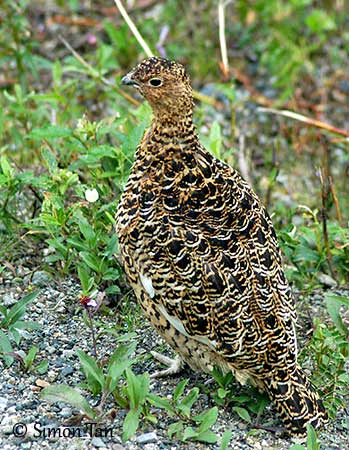
During summer, the male is rusty-brown with darker vermiculations on back. Wings, belly and legs are white. The tail is black.
The female is greyer with heavy barred/spotted pattern and small combs. Like male, she has white wings, belly and undertail-coverts.
The heavy bill is blackish with blue-grey base. The eyes are dark brown to blackish. Legs and feet are feathered white.
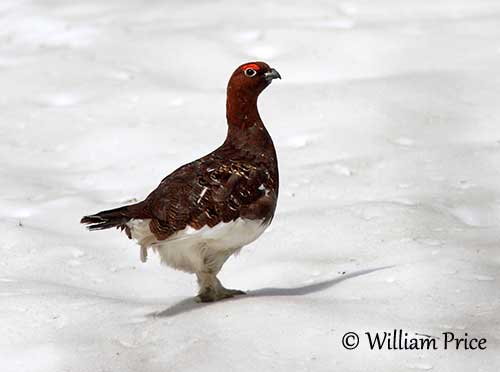
The juvenile has extensive greyish-brown plumage mottled and barred overall, including on flight feathers. The wings become whiter through the first autumn.

SUBSPECIES AND RANGE:
The Willow Ptarmigan has numerous subspecies, 16-20 according to the authors.
This species has wide range and circumboreal distribution. It is found in Canada and USA, China, Mongolia, the Russian Federation, Kazakhstan, Finland, Norway, Sweden, Estonia, Latvia, Lithuania, Germany, the United Kingdom and Ireland.
The races differ slightly in pattern and plumage coloration through the seasons, and in bill and wing sizes.
The Red Grouse (Lagopus scotica) is now a full species. It is the only one that never develops white winter plumage.
HABITAT:
The Willow Ptarmigan nests in moist environment such as treeline areas, marshy tundra and coastal regions. It favours areas with willow or birch shrubs, and can be found in areas with patches of dense vegetation in Alaska and N Canada.
During winter, it frequents more protected habitats and often moves into valleys or areas with dense vegetation within the breeding grounds.
Females and young birds often move into boreal forests, whereas males remain in subalpine habitat.
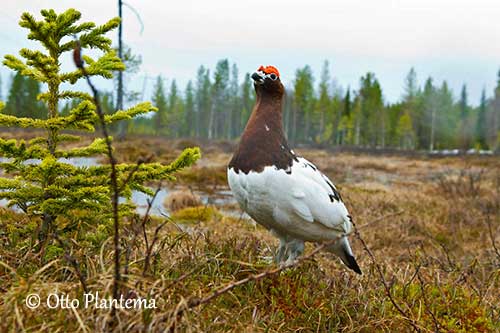
CALLS AND SONGS: SOUNDS BY XENO-CANTO
The Willow Ptarmigan male gives a strident, nasal, cackling “go-back, go-back, back, kak, kak…” given in flight or from the ground. When perched, it gives a loud, accelerating “ko-ko-ko-ko-ko-kokokokokokokrr”.
During the aerial displays, it gives a loud “aa” while rising, followed by rapid but slowing “ka-ka-ka-ka-ka-ka” while descending. On landing, it produces a gruff “kohwa-kohwa”.
The female is more silent, but both adults may give softer “kok” or “krrow” calls during threat, territorial or sexual displays, or as contact call between mates or between adults and young. While defending young or mate, both adults produces “hiss” and “scream” calls.
BEHAVIOUR IN THE WILD:
The Willow Ptarmigan feeds on buds, twigs, leaves and seeds, and is almost entirely vegetarian. It takes buds, leaves and twigs from several plant species including willow, alder and birch, but it also feeds on berries and eats occasionally some insects, usually caterpillars and beetles.
It often swallows some small gravel in order to help with digesting plant material. However, the chicks are fed first on insects and spiders, but they feed soon on plant matter.
The Willow Ptarmigan forages while walking quietly and picking at vegetation. During winter, it may take mosses and lichens too. They often feed in flocks outside the breeding season.
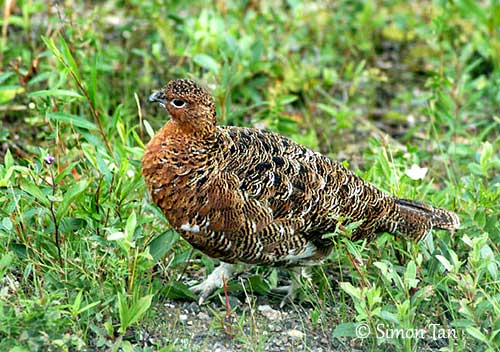
The Willow Ptarmigan may have aggressive behaviour, performing jumping and facing between two or more birds. They jump around while flapping their wings. Chases occur between a dominant and a more submissive bird. At the end of a long chase, the dominant may injure or kill the other bird. During these displays, the red combs are erect and the head is held forwards.
The females are less aggressive than males, although polygynous females fight more than monogamous females.
Once the territory is established, the Willow Ptarmigan performs courtship displays. The male cocks its tail and may fan it too. Then, it lowers the wings and scrapes the ground while approaching the female. The following displays show the male draping its wings around the female while circling her in short, high steps.
Other display show the male running towards the female with fanned tail, arched neck and head low with bill open, and bowing is also reported. Male and female perform head-wagging, extending the head side to side. Mating occurs when the female shows submissive behaviour.
The male is usually monogamous within the season, but 5-20% of males are polygynous and often have larger territories.
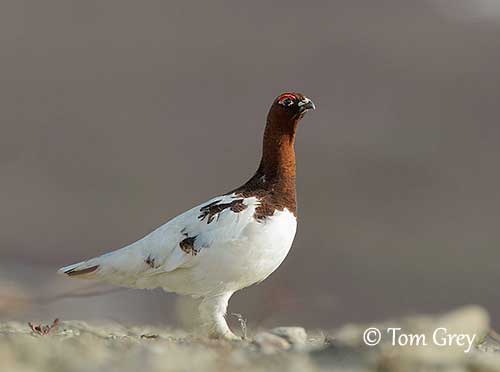
The Willow Ptarmigan is adapted to the cold weather, and remains in the Arctic all year round, frequenting thickets of dwarf willows on the tundra.
During winter, females and juveniles usually move to lower elevations and reach valleys and more vegetated areas. The males often remain in subalpine areas. This species is sedentary in some places and only performs short range altitudinal movements.
The Willow Ptarmigan usually flushes suddenly but then, the flight is swift and direct with rapid wingbeats interspersed with glides. During the displays, the male makes short flights and circles back to its starting point.
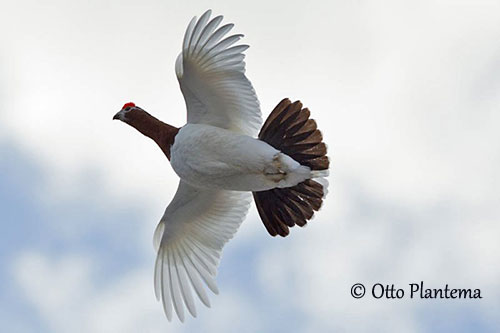
REPRODUCTION OF THIS SPECIES:
The breeding season takes place in spring, with the laying between April and June, depending on the range.
The Willow Ptarmigan nests on the ground, often under willow shrub or clump of grass, but it may sometimes nest in the open. The female builds a shallow scrape lined with soft materials such as grass, leaves, moss and /or feathers.
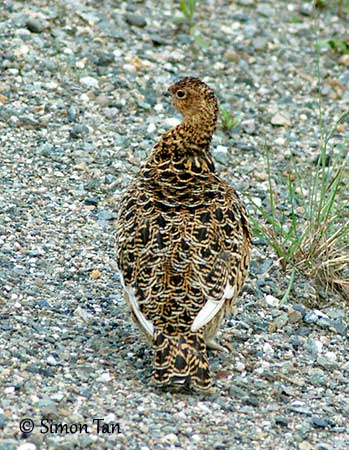
The female lays 5-14, usually 7 whitish-ochre eggs densely spotted brown, making them almost invisible on the ground. She incubates alone but guarded by the male, during 21-22 days. At hatching, the downy chicks have chestnut crown bordered by black lines. They leave the nest a few hours after hatching, accompanied by the female. She broods them during the first days (7-10 days), but the male often helps and sometimes broods the chick too.
The young are able to feed themselves. They can make short flights 10-12 days after hatching, but they need several weeks to be fully grown, between 70 and 110 days according to habitat type. They remain in family group until late summer.
The Willow Ptarmigan is the only grouse in which the male takes part in parental care.
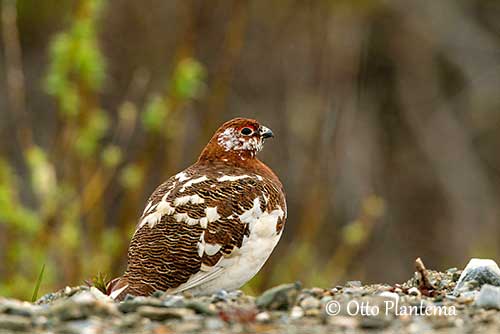
PROTECTION / THREATS / STATUS:
The Willow Ptarmigan has large range in which it is widespread and common.
Some local declines are due to overhunting. Climate changes involve some range contraction in Europe, especially in Baltic regions, Kazakhstan and SW Siberia.
Climatic warming in the Arctic has led to rapid expansion of the vegetation and may affect the populations that favour mainly willow thickets, both for feeding and nesting.
High level predation by raptors may suppress some populations for short periods.
The global population is estimated to number 40,000,000 individuals and appears fairly stable. The Willow Ptarmigan is currently evaluated as Least Concern.
